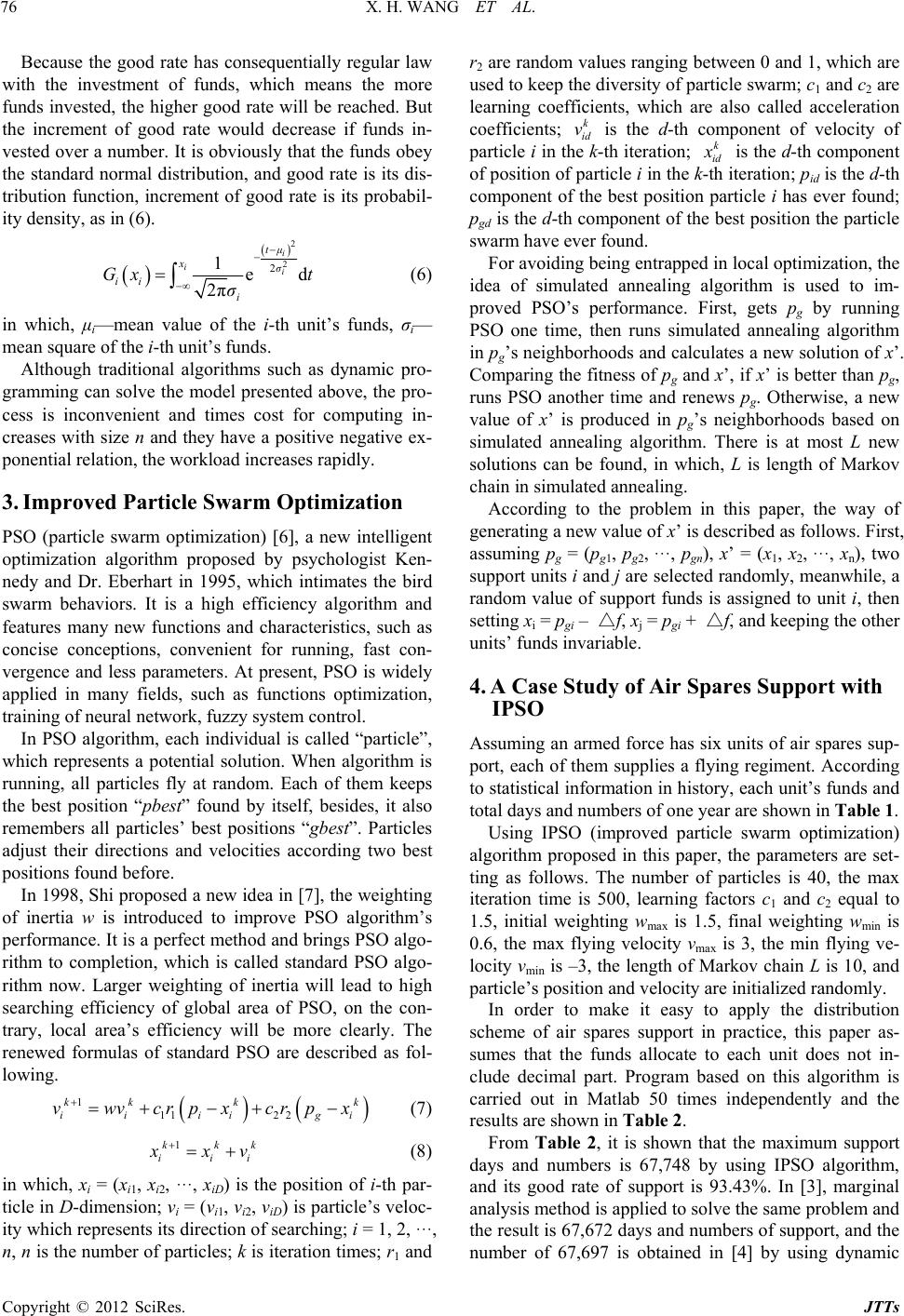
X. H. WANG ET AL.
76
Because the good rate has consequentially regular law
with the investment of funds, which means the more
funds invested, the higher good rate will be reached. But
the increment of good rate would decrease if funds in-
vested over a number. It is obviously that the funds obey
the standard normal distribution, and good rate is its dis-
tribution function, increment of good rate is its probabil-
ity density, as in (6).
2
2
2
1e
2π
i
ii
tμ
xσ
ii
i
Gx t
σ
d
k
i
k
i
(6)
in which, μi—mean value of the i-th unit’s funds, σi—
mean square of the i-th unit’s funds.
Although traditional algorithms such as dynamic pro-
gramming can solve the model presented above, the pro-
cess is inconvenient and times cost for computing in-
creases with size n and they have a positive negative ex-
ponential relation, the workload increases rapidly.
3. Improved Particle Swarm Optimization
PSO (particle swarm optimization) [6], a new intelligent
optimization algorithm proposed by psychologist Ken-
nedy and Dr. Eberhart in 1995, which intimates the bird
swarm behaviors. It is a high efficiency algorithm and
features many new functions and characteristics, such as
concise conceptions, convenient for running, fast con-
vergence and less parameters. At present, PSO is widely
applied in many fields, such as functions optimization,
training of neural network, fuzzy system control.
In PSO algorithm, each individual is called “particle”,
which represents a potential solution. When algorithm is
running, all particles fly at random. Each of them keeps
the best position “pbest” found by itself, besides, it also
remembers all particles’ best positions “gbest”. Particles
adjust their directions and velocities according two best
positions found before.
In 1998, Shi proposed a new idea in [7], the weighting
of inertia w is introduced to improve PSO algorithm’s
performance. It is a perfect method and brings PSO algo-
rithm to completion, which is called standard PSO algo-
rithm now. Larger weighting of inertia will lead to high
searching efficiency of global area of PSO, on the con-
trary, local area’s efficiency will be more clearly. The
renewed formulas of standard PSO are described as fol-
lowing.
1
112 2
kk k
ii iig
vwvcrpxcrpx
(7)
1kk
ii
xv
(8)
in which, xi = (xi1, xi2, ···, xiD) is the position of i-th par-
ticle in D-dimension; vi = (vi1, vi2, viD) is particle’s veloc-
ity which represents its direction of searching; i = 1, 2, ···,
n, n is the number of particles; k is iteration times; r1 and
r2 are random values ranging between 0 and 1, which are
used to keep the diversity of particle swarm; c1 and c2 are
learning coefficients, which are also called acceleration
coefficients; is the d-th component of velocity of
particle i in the k-th iteration;
k
id
v
k
id
is the d-th component
of position of particle i in the k-th iteration; pid is the d-th
component of the best position particle i has ever found;
pgd is the d-th component of the best position the particle
swarm have ever found.
For avoiding being entrapped in local optimization, the
idea of simulated annealing algorithm is used to im-
proved PSO’s performance. First, gets pg by running
PSO one time, then runs simulated annealing algorithm
in pg’s neighborhoods and calculates a new solution of x’.
Comparing the fitness of pg and x’, if x’ is better than pg,
runs PSO another time and renews pg. Otherwise, a new
value of x’ is produced in pg’s neighborhoods based on
simulated annealing algorithm. There is at most L new
solutions can be found, in which, L is length of Markov
chain in simulated annealing.
According to the problem in this paper, the way of
generating a new value of x’ is described as follows. First,
assuming pg = (pg1, pg2, ···, pgn), x’ = (x1, x2, ···, xn), two
support units i and j are selected randomly, meanwhile, a
random value of support funds is assigned to unit i, then
setting xi = pgi – △f, xj = pgi + △f, and keeping the other
units’ funds invariable.
4. A Case Study of Air Spares Support with
IPSO
Assuming an armed force has six units of air spares sup-
port, each of them supplies a flying regiment. According
to statistical information in history, each unit’s funds and
total days and numbers of one year are shown in Table 1.
Using IPSO (improved particle swarm optimization)
algorithm proposed in this paper, the parameters are set-
ting as follows. The number of particles is 40, the max
iteration time is 500, learning factors c1 and c2 equal to
1.5, initial weighting wma x is 1.5, final weighting wmin is
0.6, the max flying velocity vmax is 3, the min flying ve-
locity vmin is –3, the length of Markov chain L is 10, and
particle’s position and velocity are initialized randomly.
In order to make it easy to apply the distribution
scheme of air spares support in practice, this paper as-
sumes that the funds allocate to each unit does not in-
clude decimal part. Program based on this algorithm is
carried out in Matlab 50 times independently and the
results are shown in Table 2.
From Table 2, it is shown that the maximum support
days and numbers is 67,748 by using IPSO algorithm,
and its good rate of support is 93.43%. In [3], marginal
analysis method is applied to solve the same problem and
the result is 67,672 days and numbers of support, and the
number of 67,697 is obtained in [4] by using dynamic
Copyright © 2012 SciRes. JTTs